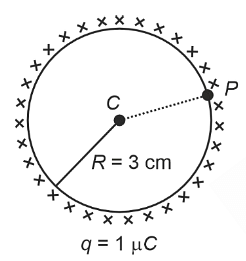A thin spherical shell is charged by some source. The potential difference between the two points C and P (in V) shown in the figure is:
(Take \(\frac{1}{4}\pi\epsilon_0 = 9 × 109\)\(\frac{1}{4\pi\epsilon_0}=9\times10^9\) SI units)

(Take \(\frac{1}{4}\pi\epsilon_0 = 9 × 109\)\(\frac{1}{4\pi\epsilon_0}=9\times10^9\) SI units)

- 3 × 105
- 1 × 105
- 0.5 × 105
- Zero
The Correct Option is D
Approach Solution - 1
To determine the potential difference between two points \( C \) and \( P \) on a charged thin spherical shell, we need to consider the properties of potential inside and outside the shell. For a thin spherical shell:
- Inside the shell (any point within the radius of the shell), the electric potential is constant. This is because the electric field inside the shell is zero due to the symmetry and Gauss's law. Therefore, the potential difference between any two points inside the shell is zero.
- Outside the shell, the shell behaves as a point charge located at its center. The potential \( V \) at a distance \( r \) from the center is given by \( V = \frac{kQ}{r} \), where \( Q \) is the total charge on the shell, and \( k = 9 \times 10^9 \, \text{Nm}^2/\text{C}^2 \).
- If the points \( C \) and \( P \) are both either inside or at the same radius from the center of the shell, the potential difference between them is zero.
Given that both points are either inside the shell or at the same radial distance, the potential difference is: Zero
Approach Solution -2
Step 1: Recall the Property of a Spherical Shell
Inside a charged spherical shell, the electric field is zero due to the symmetry of the charge distribution. Hence, the potential remains constant inside the shell.
Step 2: Potential Difference Between C and P
Since the electric field is zero inside the shell, the potential at any two points inside the shell, including C and P, is the same:
$$ V_C = V_P, \quad \Delta V = V_C - V_P = 0 $$
Step 3: Conclude
The potential difference between C and P is 0V.
Top Questions on Electric Potential And Potential Difference
- If a particle of mass 10 mg and charge 2 µC at rest is subjected to a uniform electric field of potential difference 160 V, then the velocity acquired by the particle is
- TS EAMCET - 2025
- Physics
- Electric Potential And Potential Difference
- A charge of 10 coulomb is brought from infinity to a point \( P \) near a charged body and in this process 200 joules of work is done. Electric potential at point \( P \) is:
- JEECUP - 2024
- Physics
- Electric Potential And Potential Difference
- Two point charges \( 20 \, \mu C \) and \( -10 \, \mu C \) are separated by a distance of 1 m in air. At what point on the line joining the two charges, the electric potential is zero.
- COMEDK UGET - 2023
- Physics
- Electric Potential And Potential Difference
- Choose correct graph of electric potential for uniformly charged hollow sphere.
- JEE Main - 2023
- Physics
- Electric Potential And Potential Difference
- Electric potential at a point \( P \) due to a point charge of \( 5 \times 10^{-9} \, \text{C} \) is \( 50 \, \text{V} \). The distance of \( P \) from the point charge is:
- JEE Main - 2023
- Physics
- Electric Potential And Potential Difference
Questions Asked in NEET exam
AB is a part of an electrical circuit (see figure). The potential difference \(V_A - V_B\), at the instant when current \(i = 2\) A and is increasing at a rate of 1 amp/second is:

- NEET (UG) - 2025
- Electromagnetic Induction and Inductance
- Twins are born to a family that lives next door to you. The twins are a boy and a girl. Which of the following must be true?
- NEET (UG) - 2025
- Genetics
Three identical heat conducting rods are connected in series as shown in the figure. The rods on the sides have thermal conductivity 2K while that in the middle has thermal conductivity K. The left end of the combination is maintained at temperature 3T and the right end at T. The rods are thermally insulated from outside. In steady state, temperature at the left junction is \(T_1\) and that at the right junction is \(T_2\). The ratio \(T_1 / T_2\) is

- NEET (UG) - 2025
- Conductivity-thermal and electrical
- With the help of the given pedigree, find out the probability for the birth of a child having no disease and being a carrier (has the disease mutation in one allele of the gene) in the F3 generation.

- NEET (UG) - 2025
- Genetics
- Consider the diameter of a spherical object being measured with the help of a Vernier Callipers. Suppose its 10 Vernier Scale Divisions (V.S.D.) are equal to its 9 Main Scale Divisions (M.S.D.). The least count in the M.S. is 0.1 cm and the zero of V.S. is at -0.1 cm when the jaws of Vernier callipers are closed. If the main scale reading for the diameter is \(M = 5\) cm and the number of coinciding vernier division is 8, the measured diameter after zero error correction, is:
- NEET (UG) - 2025
- Measurement of length